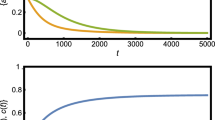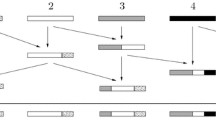Abstract
Invariance under population subdivision and the strong-migration limit are investigated for digenic samples in neutral models. The monoecious, diploid population is subdivided into a finite number of panmictic colonies that exchange gametes. The backward migration matrix is arbitrary, but time independent and ergodic (i.e., irreducible and aperiodic). Results are derived for the distribution of the place and time of coalescence, for the probability of identity in the model of infinitely many alleles, and for the distribution of the number of nucleotide differences in the model of infinitely many sites without recombination.
Similar content being viewed by others
Author information
Authors and Affiliations
Additional information
Received: 5 October 1999 / Revised version: 1 February 2000 / Published online: 4 July 2000
Rights and permissions
About this article
Cite this article
Nagylaki, T. Geographical invariance and the strong-migration limit in subdivided populations. J Math Biol 41, 123–142 (2000). https://doi.org/10.1007/s002850070002
Issue Date:
DOI: https://doi.org/10.1007/s002850070002




